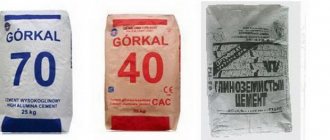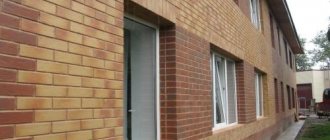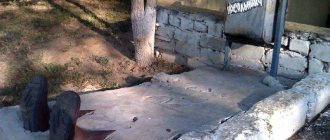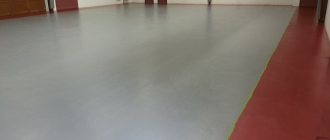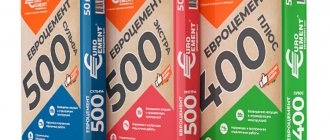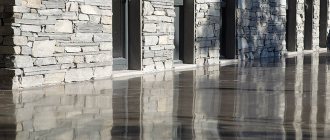Reconstruction with restoration of waterproofing of old houses is even more complex than new construction. In this case, in a building it may be necessary, for example, to drain and clean the basement, and then remove dirt, peeling plaster, and wet parts of the screed.
Using ordinary concrete when carrying out such repairs may not be a very successful solution. After all, it takes several hours for cement mixtures of standard composition to set. During this time, the solution will be easily washed away by water. Therefore, when reconstructing old buildings and structures, concrete mixtures of a special type are often used - quick-hardening ones. This type of cement is in very wide demand in construction. The article presents the main characteristics of this material.
Compound
Many companies produce such building material. If desired, today you can buy mixtures of this variety from a variety of manufacturers. The specific proportional composition of quick-hardening cements is a trade secret of the companies that produce them. It is usually not indicated as a percentage on the packaging of such materials.
But in any case, the basis of such mixtures, like conventional ones, is cement. Manufacturers can use the following components as additives that give the finished solution the ability to set quickly:
- Quicklime.
- Potash.
- Hydrochloric acid.
- Various types of salts.
Depending on the type of additive, the hardening time of such solutions may vary within certain limits. Of course, in the production of building materials of this type, various kinds of components can be additionally used to increase their plasticity, waterproofing properties, and chemical resistance.
Quick-hardening cement - material features
The main condition in the production of quick-setting cement is high-quality raw materials with a minimum content of impurities and a uniform chemical composition. The structure of materials is of no small importance for interaction, so preference is given to amorphous rather than crystalline components.
Currently, there are two methods for achieving the effect of rapid hardening of concrete:
- special preparation of clinker based on grinding the material to a particle size with a reduced surface area. This is the basis for the interaction of the binder with water;
- the use of mineralized raw materials represents the second way to reduce the setting time of concrete in mortar.
The main component is clinker with a high content of three-finger silicates and aluminum salts. Finely ground gypsum or calcium chloride can be used as additional chemical elements, as evidenced by the markings on the packaging.
Important! Clinker for cement production is obtained by firing a certain ratio of clay and lime at high temperatures. To improve the characteristics of cement, mineral substances and plasticizers are added to the clinker powder.
Cooking methods
Now there are two main types of such building materials on the market. Most often, when repairing and constructing buildings, it is quick-hardening dry mixtures that are used. Components that ensure rapid setting are added to the composition of such a material already at the production stage.
Also, quick-hardening cement-based mortars can be prepared directly on the construction site. In this case, complete with the dry material itself there is a canister or bottle of liquid that contains additives for quick setting. When preparing the solution, it is added to the mixture instead of water.
Manufacturing
The production of intensively hardening cement is carried out using high-precision equipment. All premium ingredients are extremely finely ground.
The resulting tiny granules of the dry mixture form a very large area of contact with water. The amorphous structure of the crushed components facilitates their chemical interaction. Thanks to this technological feature, the full curing cycle of mixed cement is significantly reduced.
The hardening speed can also be increased by adding sodium chloride (NaCl), calcium chloride (CaCl₂), sodium sulfate (Na₂SO₄), hydrochloric acid (HCl) or other substances. The most common addition is calcium chloride (1-2% by weight of cement), which is effective during the first stages of curing.
Scope of application
Most often, quick-setting cement mixtures are used specifically for the reconstruction of buildings and structures. In such houses they can be used, for example, for waterproofing, puttying, sealing:
- Seams.
- Cracks.
- Gaps.
- Holes.
Very often, basements and foundations of old buildings are repaired using such materials.
In new construction, such materials are used to quickly attach anchors, any other metal structures, and all kinds of parts to concrete. In some cases, such solutions are also used when laying stoves. Also, this type of material can be used for the manufacture of stucco interior decorations when installing columns.
CERESIT CN 83 repair mortar for floors
Ceresit CN 83 is used for operation under conditions of high mechanical loads, in dry and wet rooms, inside and outside buildings, in civil and industrial construction.
Ceresit CN 83 has improved abrasion resistance and is primarily used as an uncoated final coat.
Specifications
Composition of Ceresit CN 83:
a mixture of cement with mineral fillers and polymer modifiers
Dry mixture density:
about 1.65 kg/dm3
Mixing water quantity:
3.0 - 3.2 l per 25 kg of dry mixture
Possibility of technological movement:
Compressive strength: after 1 day after 3 days after 28 days
not less than 13 MPa not less than 23 MPa not less than 35 MPa
Tensile strength during bending: after 1 day after 3 days after 28
days not less than 3.0 MPa not less than 3.5 MPa not less than 5.5 MPa
not less than 100 N/mm2
Adhesion to the base in the presence of: a contact layer of ST 17 primer
not less than 1.5 MPa not less than 0.9 MPa
Ready for installation: ceramic tile flooring and self-leveling cement mixtures of parquet and self-leveling polymer floors
after 72 hours after 7 days
Consumption of Ceresit CN 83:
about 2.0 kg/m2 per mm of layer thickness
Material consumption when applying the contact layer:
about 2.8 kg of Ceresit CN 83, 0.2 l of Ceresit SS 81 and 0.4 l of water per m? area
Brands and manufacturers
In Russia, the following companies produce concrete mixtures of this type:
- MAPEI. Concrete from this manufacturer is supplied to the market under the Mapefill brand. This company was founded in the 30s of the last century in Italy. Currently it is the largest European manufacturer of building mixtures, including quick-setting ones.
- "KT Tron." This domestic manufacturer has been operating in Russia for more than 20 years. In addition to fast-hardening cements, it supplies the market with waterproofing compounds and sealants.
- "BIRSS." It is also a domestic manufacturer that supplies the market with the highest quality building mixtures. Quick-hardening cement from this company is of excellent quality and is relatively inexpensive. The company also produces mixtures for self-leveling floors, plaster, putty and others.
There are only two brands of such mixtures on the modern domestic market: M400 and M500. Fast-hardening cement M500 differs from M400 only in that after hardening it is able to withstand greater loads. Such mixtures are usually used when repairing foundations and attaching critical metal structures to concrete foundations.
Installation of beacons
Beacons for screeds
Lighthouses
For an even screed, beacons are installed - special metal profiles or wood blocks. The guides are located at the same level, where the height of the screed ends above the base. The work is performed with a level or level.
During installation, the horizontalness and height of the beacons are checked
Checking the horizontality of beacons
The beacon can be located in the screed or removed from it after the structure is completed. If the guide remains in the screed, it is treated with anti-corrosion and water-repellent compounds. But it is better to remove wood products from the structure, as they are susceptible to destruction.
Stages of work.
- About 25 cm is removed from the wall and the first beacon is installed. The remaining products are located at a distance of approximately 40 cm from it.
- In the place where the profile will be placed, tubercles are made of cement with a small distance between them. The beacon rests on the tubercles.
- The guides are placed around the perimeter of the room and left until the cement solution dries. Afterwards the screed is performed.
Basic properties
The main difference between quick-setting cement mortars and conventional ones is precisely the ability to turn into stone in a short period of time. Depending on the manufacturer and the additives used, such mixtures can harden within 1 to 5 minutes. Most often on the market today you can find materials that harden in about 3 minutes.
Nowadays, quick-hardening mixtures that are capable of self-compacting are produced. The advantage of using such solutions is that they can penetrate into microcracks during the setting process and expand in volume.
Any brand of quick-hardening cement produced these days is distinguished by its waterproofing properties. Materials of this variety are capable of hardening even in the presence of quite strong water pressure. Under such conditions, they do not erode and create an airtight plug, which can subsequently last for a very long time. In most cases, such solutions are able to set well and quickly even under water or in the cold.
Production of quick-hardening concrete
Production of quick-hardening cement
When producing a material that has the property of accelerated hardening, the finest grinding of the components is necessary. Small granules increase the area of interaction with moisture, accelerating hydration. Quick-setting cement has a specific surface area of 3500 square meters. cm/g, and a regular product - 2800. A particularly fast-hardening composition generally has an active area of up to 9000 sq. cm/g. When such cement dust hardens in natural conditions, after 3 hours it is already possible to dismantle the formwork, and after a day the concrete has two-thirds of its final strength.
How to use it correctly
The method of preparing quick-setting material is practically no different from the method of mixing conventional cement mixtures. However, it is important to understand that you cannot prepare a lot of this solution at once. Mix a dose that can be used within 1-5 minutes.
It is not recommended to dilute a quick-setting compound that has already begun to harden with anything. If this is done, the performance characteristics of the finished material will sharply decrease. When preparing such solutions, the following rules are usually required:
- Water or a special liquid should be added to the composition gradually, in small portions, until a paste-like mass is obtained.
- The total time for preparing the solution should not exceed that specified in the manufacturer's instructions.
- The surface for the “patch” should be prepared and cleaned in advance.
- The prepared solution should be used immediately.
BTC production
Types of cement.
Rapid-hardening cement without additives is obtained when it is subjected to finer grinding at the enterprise. The smaller the granules, the larger the area of contact with the reagent they will provide, and therefore the hydration activity increases. It is worth comparing the specific surface area of BTC and conventional cement. For the first it fluctuates in the range of 3.5-4 thousand cm2/g of substance, and for the second - 2.8-3 thousand cm2/g. It must be said that there are especially fast-hardening cements in which the active area is increased to 7-9 thousand cm2/g. Concrete products made from them, hardening in natural conditions, are ready for removal of formwork within 2-4 hours after pouring. During this time, the concrete reaches a strength of 100 kg/cm2, and the next day the structure gains 2/3 of its design strength.
As already written, this method of producing BTC is not cheap, therefore, to give the binder the necessary characteristics, many manufacturers use the addition of various mineral additives to it. However, fast-hardening concrete made from BTC with additives will not harden as quickly as a mortar made from finely ground cement.
In any case, GOST 10178-62 regulates the characteristics of quick-hardening cement.
The strength of the substance on the third day after mixing with water should not be lower than 40 kg/cm2 (hardening of the solution should take place under normal conditions).
special instructions
Mixing waterproof quick-hardening cement is usually done using a construction mixer. It is believed that this procedure, despite the need to quickly prepare a plastic mixture, cannot be performed at too high speeds. This may lead to deterioration of the properties of the finished solution.
If there is a backwater of water, the area to be corrected is first rubbed with a dry quick-setting mixture. Then a second layer of a solution prepared using liquid or water is applied over the resulting patch.
Acceleration of concrete hardening
Composition and proportions for preparing concrete based on granite and cement.
To obtain fast-hardening concrete with high strength characteristics, achieved under natural conditions already in the first days after pouring, you can also use ordinary cement. Methods to speed up the hardening of concrete include:
- reduction of cement and water components in the solution (lean concrete);
- the use of modifiers that activate hydration;
- grinding the binder component with the addition of gypsum.
Lean concrete also includes grade 200 concrete mortar, from which floor structures can be made. Less grade solutions are used in preparing foundations before road construction and building construction. Acceleration of concrete hardening is achieved thanks to a smaller amount of reagents, due to which the hydration process occurs much faster. When making so-called hard concrete, you cannot increase the dosage of water, since its excess will lead to a deterioration in the quality of the solution.
Concrete hardens faster if calcium chloride is added to the solution during preparation. Its content in concrete should not exceed 3%. If a reinforced concrete structure is made, the amount of CaCl2 is reduced to 2%. This modifier cannot be added to solutions that will be used to fill reinforced concrete structures with reinforcement with a cross-section thinner than 4 mm, as it will cause metal corrosion. It is not recommended to use it for the construction of long-term reinforced concrete products. It should be added that calcium chloride is added to the mixture along with water. Before pouring the liquid into concrete, the modifier must be dissolved in it. Experts advise adding CaCl2 to pozzolanic cements, slag Portland cements and cements with a long hardening time.
Rapid-hardening concrete, which gains up to 50-55% of the design strength during the first day of hardening, is obtained by grinding and adding gypsum to it, the content of which in the binder component is brought to 3%. However, laboratory experiments have shown that cement-based concrete with an 8 percent gypsum content showed the best hardening performance. The experts who conducted the research noted that high-strength gypsum is a more effective hardener. Concrete prepared with this modifier, in terms of strength, was almost 1.5 times higher than the solution to which ordinary building gypsum was added.
Tile adhesive: varieties, choice, consumption
The composition for laying tiles or porcelain stoneware differs from a simple cement-sand mortar in terms of operational and performance indicators. Tile adhesive is more durable, flexible, easy to apply and hardens faster. It is sold in the form of a dry mixture. The powder can be stored for a long time, diluting only the volume required for work.
- Description and properties of the material
- Composition and characteristics
- Scope of application
- Types of tile adhesive
- By purpose
- By properties
- Criterias of choice
- Recommendations for use
- How to calculate consumption
- Surface preparation
- How to dilute glue
- Technology of installing tiles with glue
- Review of manufacturers

